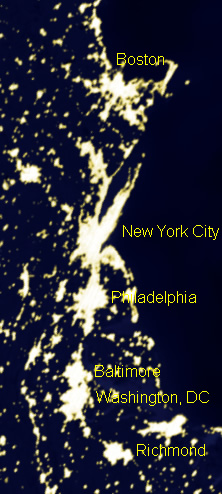The pattern of settlement at a particular time and place results from the choices humans make from those offered by the natural environment. These choices are based on three variable factors: population, the materials and technology available, and cultural requirements. The accelerating increase in numbers of people in modern times has led to vastly greater pressure on land. Technological progress enables people to overcome the constraints and to exploit the opportunities presented by nature.
Ultimately, many societies may emulate the United States legislation which requires studies of environmental impact to be made before construction is carried out using government funds.
The conservation-exploitation debate about land and what to do with it acknowledges that land, which covers about 25 per cent of the Earth's surface, may be limited whereas human numbers, capabilities and demands are not.
Settlement Growth
The term settlement includes the establishment of villages and towns as well as the pattern of human concentration at a given time and place.
For fewer than 10,000 years mankind has lived in places where specialized activity was possible.
Towns and cities have come to dominate large hinterlands from which they draw food and other resources, although they occupy small areas of land.
With the rise of the European colonial systems during the last 500 years certain cities such as London or Paris were able to expand the hinterlands from which resources could be drawn because the means were found to move people, commodities, and goods over long distances.
 Today urbanization continues apace with some groups of cities merging into a super-city or megalopolis, as has happened in the north-eastern United States along the Atlantic seaboard from Boston to Washington DC, known as BosWash, BoWash or BosNYwash.
Today urbanization continues apace with some groups of cities merging into a super-city or megalopolis, as has happened in the north-eastern United States along the Atlantic seaboard from Boston to Washington DC, known as BosWash, BoWash or BosNYwash.
Individual cities expand as migrants move into them from smaller settlements and from rural areas, and birth rates remain high in most countries.
In the 1920s there were about 24 cities with more than a million inhabitants. Today there are over 300 such cities, one third of which are in China, and there has been a gradual trend in recent decades for "million cities" to develop in the tropical latitudes.
The fastest growth in the late twentieth century has occurred in some Third World cities. Mexico City, for example, had more than 8,836,045 million citizens in 2008, ahead even of Tokyo (8 million) and the New York City (8.3 million). Large cities of the past such as London and Paris seem modest by comparison with a population of little more than 7.5 million and 2.1 million respectively - though the Greater London and Paris metropolitan areas are much larger.
Modern Cities' Land Use
Growing major cities in modern times consume land for industry, commerce, housing, administration and public services such as health and education, as well as open space for recreation.
Linking such urban sub-divisions and connecting the city to other parts of a system of settlement is "transport space". This space carries transport networks such as road, rail and other routes to terminal sites such as stations, airports and ports. It also includes ancillary transport storage and supply land, such as garages, works and parking space.
Another major feature of modem urban settlement is the multiple use of land. Buildings in the center of a metropolis may have several stories; street levels may be used for retail or transport, and upper floors for residential, commercial or manufacturing functions.
The greatest concentrations come in inner city or central business districts. Such settlements depend on land far beyond their own limits, for food and other supplies, and for markets.
At the other end of the settlement scale, modern villages may be small but are increasingly "urban" and no longer expect to subsist on production from local land. Many villages today are dormitory settlements for commuters working in nearby urban centers.
Nomads have long used inhospitable land that was not able to support fixed communities but where water and other resources were adequate for temporary use. Such specialized man-land relationships have expanded the usable land area (ecumene) in a transient and thinly-spread way.
Modern people can also live in such marginal areas. Supplies and equipment for a comfortable lifestyle can be transported to outlying areas and radio communications can keep them in touch with the metropolis. Prudhoe Bay on the north Alaskan oilfield, for example, is an isolated community maintained by inland urban contact.
Settlement Affect Land
Land consists of sub-surface and surface features which, along with climate, constitute the natural environment. It may be thought of as a constant until we realize the extent of the impact of settlement on the land: groundwater tables are lowered by pumping and forests are replaced by farmland and settlements.
In the cities, vast areas are relentlessly buried under concrete and asphalt. Such losses can to some extent be countered by the extension of the usable land area with irrigation and reclamation projects or reafforestation - perhaps eventually by schemes to change the climate of large areas.